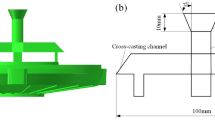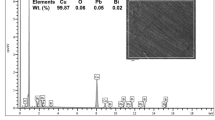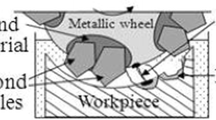Abstract
This paper reports an intelligent approach for modeling and optimisation of filling system design (FSD) in the case of sand casting process of aluminium alloy. In order to achieve this purpose, physics-based process modeling using finite element method (FEM) has been integrated with artificial neural networks (ANN) and genetic algorithm (GA) soft computing techniques. A three-dimensional FE model of the studied process has been developed and validated, using experimental literature data, to predict two melt flow behaviour (MFB) indexes named ingate velocity and jet high. Two feed-forward back-propagation ANN-based process models were developed and optimised to establish the relationship between the FSD input parameters and each studied MFB index. Both ANN models were trained, tested and tuned by using database generated from FE computations. It was found that both ANN models could independently predict, with a high accuracy, the values of the ingate velocity and the jet high for training and test data. The developed ANN models were coupled with an evolutionary GA to select the optimal FSD for each one. The validity of the found solutions was tested by comparing ANN-GA prediction with FE computation for both studied MFB indexes. It was found that error between predicted and simulated values does not exceed 5.61% and 6.31% respectively for the ingate velocity and the jet high, which proves that the proposed approach is reliable and robust for FSD optimisation.











Similar content being viewed by others
Data availability
Not applicable.
Abbreviations
- ANN:
-
Artificial neural networks
- CAD:
-
Computer-aided design
- FEM:
-
Finite element method
- FFBP:
-
Feed-forward back-propagation
- FSD:
-
Filling system design
- GA:
-
Genetic algorithm
- logsig:
-
Log-sigmoid transfer function
- MFB:
-
Melt flow behaviour
- MSE:
-
Mean square error
- PSO:
-
Particle swarm optimisation
- purelin:
-
Linear transfer function
- trainlm:
-
Levenberg-Marquardt training algorithm
- traingdx:
-
Gradient descent with momentum and adaptive learning rate training algorithm
- tansig:
-
Tan-sigmoid transfer function
- SQP:
-
Sequential quadratic programming
- VOF:
-
Volume of fluid
- 3DSP:
-
Three-dimensional sand printing
- LPC:
-
Low-pressure casting
- EPSC-VL:
-
Expendable pattern shell casting process with vacuum and low pressure
References
Bozchaloei GE, Varahram N, Davami P, Kim SK (2012) Effect of oxide bifilms on the mechanical properties of cast Al-7Si-0.3 Mg alloy and the roll of runner height after filter on their formation. Mater Sci Eng A 548:99–105
Sama SR, Badamo T, Lynch P, Manogharan G (2019) Novel sprue design in metal casting via 3D sand-printing. Addit Manuf 25:563–578
Pradhan AR, Pattnaik S, Sutar MK (2019) Improving the filling system for a defect free casting: a review. Materials Today: Proceedings 18:2887–2892
Campbell J (1993) Invisible macro defects in castings. Journal de Physique IV The third European Conference on Advanced Materials and Processes C7:861-872.
Ruddle RW (1956) The running and gating of sand casting. Inst Met Monogr Rep Ser 19
Swift RE, Jackson JH, Eastwood LW (1949) A study of principles of gating. AFS Trans 57:76–88
Renukananda KH, Ravi B (2016) Multi-gate systems in casting process: comparative study of liquid metal and water flow. Mater Manuf Process 31(8):1091–1101
Cuesta R, Maroto JA, Morinigo D, De Castro I, Mozo D (2006) Water analogue experiments as an accurate simulation method of the filling of aluminum castings. Trans Am Foundrymens Soc 114:137–150
Kuo J, Huang P, Lai H et al (2017) Optimal gating system design for investment casting of 17-4PH stainless steel enclosed impeller by numerical simulation and experimental verification. Int J Adv Manuf Technol 92:1093–1103
Huang P, Lin C (2015) Computer-aided modeling and experimental verification of optimal gating system design for investment casting of precision rotor. Int J Adv Manuf Technol 79:997–1006
Sun Z, Hu H, Chen X (2008) Numerical optimization of gating system parameters for a magnesium alloy casting with multiple performance characteristics. J Mater Process Technol 199(1-3):256–264
Beckermann C (1992) Water modeling of steel flow, air entrainment and filtration, September, SFSA T&O Conference.
Shaikh MBN, Ahmad S, Khan A, Ali M (2018) Optimization of multi-gate systems in casting process: experimental and simulation studies. IOP Conference Series: Materials Science and Engineering IOP Publishing 404 No 1.012040.
Sun W, Bates CE (2003) Visualizing defect formation in gray iron castings using real time X-rays. Trans Am Foundrymens Soc 111:859–867
Juretzko FR, Stefanescu DM (2005) Comparison of mold filling simulation with high speed video recording of real-time mold filling. AFS Trans 113:1–11
Sama SR, MacDonald E, Voigt R, Manogharan G (2019) Measurement of metal velocity in sand casting during mold filling. Metals 9:1079
Ingle PD, Narkhede BE (2018) A literature survey of methods to study and analyze the gating system design for its effect on casting quality. Mater Today Proc 5:5421–5429
Ransing RS, Sood MP (2006) Optimization in castings—an overview of relevant computational technologies and future challenges. Metall Mater Trans B 37:905–911
Jezierski J, Dojka R, Janerka K (2018) Optimizing the gating system for steel castings. Metals 8(4):266
Esparza CE, Guerrero-Mata MP, Rios-Mercado RZ (2006) Optimal design of gating systems by gradient search methods. Comput Mater Sci 36:457–467
Dučić N, Ćojbašić Ž, Manasijević S, Radiša R, Slavković R, Milićević I (2017) Optimization of the gating system for sand casting using genetic algorithm. Int J Metalcast 11:255–265
Kor J, Chen X, Hu H (2009) Multi-objective optimal gating and riser design for metal-casting, IEEE Control Applications, (CCA) & Intelligent Control, (ISIC), St. Petersburg 428-433. https://doi.org/10.1109/CCA.2009.5280821
Chen WJ, Lin CX, Chen YT, Lin JR (2016) Optimization design of a gating system for sand casting aluminium A356 using a Taguchi method and multi-objective culture-based QPSO algorithm. Adv Mech Eng 8:1–14
Yang X, Din T, Campbell J (1998) Liquid metal flow in moulds with off-set sprue. Int J Cast Metal Res 11(1):1–12
Sama SR, Wang J, Manogharan G (2018) Non-conventional mold design for metal casting using 3D sand printing. J Manuf Process 34:765–775
Bedel M, Sanitas A, El Mansori M (2019) Geometrical effects on filling dynamics in low pressure casting of light alloys. J Manuf Process 45:194–207
Jiang WM, Fan ZT, Liu DJ, Liao DF, Zhao Z, Dong XP, Wu HB (2012) Influence of process parameters on filling ability of A356 aluminium alloy in expendable pattern shell casting with vacuum and low pressure. Int J Cast Metal Res 25:47–52
Jiang W, Fan Z, Liu D, Wu B (2013) Influence of gas flowrate on filling ability and internal quality of A356 aluminum alloy castings fabricated using the expendable pattern shell casting with vacuum and low pressure. Int J Adv Manuf Technol 67:2459–2468
Sirrell B, Holliday M, Campbell J (1996) Benchmark testing the flow and solidification modeling of Al castings. JOM 48(3):20–23
Jiaqi W, Paixian F, Hongwei L, Dianzhong L, Yiyi L (2012) Shrinkage porosity criteria and optimized design of a 100-ton 30Cr2Ni4MoV forging ingot. Mater Des 35:446–456
Ravindran K, Lewis RW (1998) Finite element modelling of solidification effects in mould filling. Finite Elem Anal Des 31(2):99–116
Lewis RW, Ransing RS (2000) The optimal design of interfacial heat transfer coefficients via a thermal stress model. Finite Elem Anal Des 34:193–209
Gethin DT, Lewis RW, Tadayon MR (1992) A finite element approach for modelling metal flow and pressurised solidification in the squeeze casting process. Int J Numer Methods Eng 35:939–950
Swaminathan CR, Voller VR (1994) A time-implicit filling algorithm. Appl Math Model 18(2:101–108
Postek EW, Lewis RW, Gethin DT (2008) Finite element modelling of the squeeze casting process. Int J Numer Method H 18(3/4):325–355
Mondy L, Rao R, Brooks C et al. (2007) Wetting and free surface flow modeling for potting and encapsulation, Sandia National Laboratories Albuquerque, New Mexico 87185 and Livermore, California 94550.
Baoguang S, Xiuhong K, Dianzhong L (2010) A novel technique for reducing macrosegregation in heavy steel ingots. J Mater Process Technol 210:703–711
Nastac L, Stefanescu DM (1996) Macrotransport-solidification kinetics modeling of equiaxed dendritic growth: part II. Computation problems and validation on INCONEL 718 superalloy castings. Metall Mater Trans A 27:1996–4075
ProCast User Manual Version 2009 (2009) 1. ESI group. The virtual try-out space company
Valencia JJ, Quested PN (2008) Thermophysical properties, ASM handbook: casting ASM Handbook Committee 15:468-481.
Sun HC, Chao LS (2009) An investigation into the effective heat transfer coefficient in the casting of aluminium in a green-sand mold. Mater Trans 50(6):1396–1403
Assael MJ, Kakosimos K, Banish RM, Brillo J, Egry I, Brooks R, Quested PN, Mills KC, Nagashima A, Sato Y, Wakeham WA (2006) Reference data for the density and viscosity of liquid aluminum and liquid iron. J Phys Chem Ref Data 35:285–300
Ktari A, El Mansori M (2020) Digital twin of functional gating system in 3D printed molds for sand casting using a neural network. J Intell Manuf. https://doi.org/10.1007/s10845-020-01699-3
Levy PS, Lemeshow S (2013) Sampling of populations: methods and applications. Wiley, Hoboken
Robbins H (1985) Some aspects of the sequential design of experiments, Herbert Robbins Selected Papers. Springer, Berlin, pp 169–177
Marshall MN (1996) Sampling for qualitative research. Fam Pract 13(6):522–526
Montgomery DC (2017) Design and analysis of experiments. Wiley, Hobo-ken
Roy RK (2001) Design of experiments using the Taguchi approach: 16 steps to product and process improvement. Wiley, New York
Campbell J (2015) Complete casting handbook: metal casting processes, metallurgy, techniques and design, 2nd edn. Butterworth-Heinemann, Oxford
Gnana SK, Deepa SN (2013) Review on methods to fix number of hidden neurons in neural networks. Math Probl Eng 6. https://doi.org/10.1155/2013/425740
Awolusia TF, Oke OL, Akinkurolere OO et al (2019) Performance comparison of neural network training algorithms in the modelling properties of steel fiber reinforced concrete. Heliyon 5. https://doi.org/10.1016/j.heliyon.2018.e01115
Adeoti O, Osanaiye PA (2013) Effect of training algorithms on the performance of ANN for pattern recognition of bivariate process. Int J Comput Appl 69:8–12
Coskun N, Yildrim T (2003) The effects of training algorithms in MLP network on image classification, in Proc. Int Joint Conf on Neural Netw 2:1223–1226
Khayet M, Cojocaru C (2012) Artificial neural network modeling and optimization of desalination by air gap membrane distillation. Sep Purif Technol 86:171–182
Golberg DG (1954) Genetic algorithms in search, optimization and machine learning. Addison-Wesley Publishing Company Inc., Boston ISBN: 978-0-201-15767-3
Demuth H, Beale M (1996) Matlab Neural Network For Use with MATLAB, User's Guide, Version 4, The Math Works, Inc.
Johnson FH, Eyring H, Polissar MJ (1954) The kinetic basis of molecular biology J, vol 286. Wiley & Sons, Inc, New York
Code availability
Not applicable.
Author information
Authors and Affiliations
Contributions
AK planned and carried out the simulations. AK and ME contributed to the analysis of the results and to the writing of the manuscript.
Corresponding author
Ethics declarations
Ethics approval and consent to participate
Not applicable.
Conflict of interest
The authors declare no competing interests.
Additional information
Publisher’s note
Springer Nature remains neutral with regard to jurisdictional claims in published maps and institutional affiliations.
Rights and permissions
About this article
Cite this article
Ktari, A., El Mansori, M. Intelligent approach based on FEM simulations and soft computing techniques for filling system design optimisation in sand casting processes. Int J Adv Manuf Technol 114, 981–995 (2021). https://doi.org/10.1007/s00170-021-06876-z
Received:
Accepted:
Published:
Issue Date:
DOI: https://doi.org/10.1007/s00170-021-06876-z




